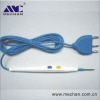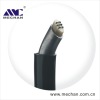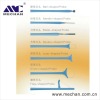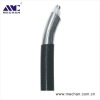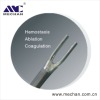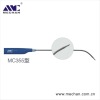Plasma Wand for Inferior Tubinate Volume Reduction
Plasma Wand for Tubinate Reduction Inferior Turbinate Volume Reduction Submucosal Plasma Ablation Minimally-invasive Surgery Plasma Wand for Tubinate Reduction (MC345)---- The Standard Instrument for Minimally-invasive Surgery of Inferior Turbinate Volume Reduction
Related clinical applications: Designed for plasma cutting / resection, ablation, coagulation and hemostasis of soft tissues during inferior turbinate volume reduction.
The Mechan ENT Plasma Turbinate Probe (MC345) is designed to reduce turbinate hypertrophy while maintaining normal nasal function. It’s a surgical instrument to gently dissolve submucosal tissues at the molecular level while preserving the mucosal surface during turbinate reduction procedures. It’s excellent in immediate and sustained tissue reduction. Features of ENT Plasma Nasal Concha / Turbinate Probe (MC345):Minimally-invasive plasma ablation and coagulation functions.·Improved tissue ablation for ENT surgical procedures of turbinate·Bipolar coagulation for achieving efficient hemostasis during ENT surgeriesEfficient and Safe·Immediate and sustained tissue ablation and removal, with reduced blood loss·Minimal thermal spread to surrounding tissues·Submucosal tissue ablation at the molecular level while preserving the mucosal surface Design of probe tip angle to ensure an easy access to nasal concha / turbinate Surgeon's words:This is my preferred method of minimally invasive turbinate reduction.This method does not provide enough reduction for some situations but most patients with turbinate enlargement will get satisfactory relief. The procedure is done by passing a small probe, like a wire, under the surface of the turbinate. On the tip of the wire is an electrode that in conjunction with a very special frequency and voltage of electricity, forms a sodium ion plasma from the electrolytes in your tissues. This plasma cloud acts to vaporize tissues and coagulate vessels. It accomplishes this with less heat than standard cauterization techniques that have been used for decades. Less heat mean less post operative discomfort and less healing time. When patients have this done at the office as an isolated procedure, they can drive themselves home and go to work that day or the next. There is very little discomfort and the results may be seen in just a week or two.This technique, in my mind, is most helpful for decreasing the wideness of the inferior turbinate. The direct removal alluded to above more specifically treats the hieght of the turbinate.
Plasma Wand for Inferior Tubinate Volume Reduction



